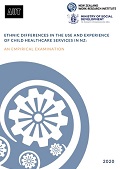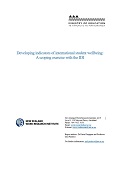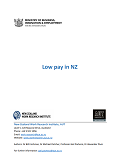Underemployment and wage growth during COVID-19
This journal article analyses the impact of the COVID-19 pandemic on earnings progression for underutilised workers, with a focus on underemployed workers. It uses data from the NZ Household Labour Force Survey and Stats NZ's Integrated Data Infrastructure. Economic shocks usually hit vulnerable workers the hardest. But this research suggests that the pandemic was different, with the gap in employment and earnings between underemployed workers and fully-utilised workers decreasing. This paper discusses the role that government policy may have played.
Gender and ethnic pay gaps: An industry-level portrait of Aotearoa
This report provides a descriptive examination of gender and ethnicity pay gaps at the industry level in Aotearoa New Zealand (NZ). We employ survey and administrative data to estimate industry pay gaps between 2016 and 2022, and then explore the structural and contextual factors driving these gaps.
Partisanship, elections and lockdowns: Evidence from US states
This article explores the differences in COVID-19 lockdown policies across U.S. states in 2020, analysing how elections and political affiliations influenced these decisions. Results show that Republican-led states, especially those facing upcoming elections, implemented less strict lockdown measures compared to Democratic-led states.
Assessing the impact of the COVID-19 pandemic on childhood vaccine uptake with administrative data
This study examines the impact of the COVID-19 pandemic on childhood vaccination coverage in NZ using population-wide administrative data. The study compares children who became eligible for immunisation during the pandemic to earlier born cohorts and finds that compared to pre-pandemic levels, the number of timely immunisations dropped during the initial phase of the pandemic. This decrease was especially pronounced among older children (aged four).
New Zealand literacy projections 2018-2033
The aim of this paper is to derive projections of the average literacy score attained by the population, by gender and Māori /non-Māori, for an aggregate set of New Zealand regions. The estimated projections in this research illustrate a slow, gradual change in literacy levels over time, accompanied by a widening gap between regions' levels of literacy proficiency. The gap between Māori and non-Māori literacy scores (favouring non-Māori) is comparatively large and constant across the projection periods.
Distributional analysis of KiwiSaver contributions
This report uses data from the IDI to examine examine KiwiSaver contributions and how these differ by gender and ethnicity, in addition to other demographic and socioeconomic characteristics.
Sexual orientation and earnings in New Zealand
This paper provides the first evidence on sexual orientation and earnings in New Zealand (NZ), one of the most inclusive countries for LGBTQ+ people in the world. We use confidential linked census-tax data to compare outcomes for individuals in same-sex couples versus different-sex couples. We find patterns of earnings differentials in NZ that are strikingly similar to those documented in other developed countries: men in same-sex couples earn about 7 percent less than otherwise similar men in different-sex couples while women in same-sex couples earn about 6 percent more than otherwise similar women in different-sex couples.
Workforce vaccine mandates: The effect on vaccine uptake and healthcare workers’ labour market outcomes
As part of its COVID-19 policy response, the New Zealand government implemented vaccination mandates as a condition of ongoing employment for certain workers. This paper examines the effect of these mandates on vaccination uptake among mandated healthcare, education and corrections workers and on healthcare workers’ labour market outcomes. This is enabled by New Zealand’s linked population-wide administrative data, which includes a comprehensive national COVID-19 vaccination register linked to tax records to identify employment outcomes.
Underutilised workers in New Zealand
Labour underutilisation has large negative implications both at the micro and macroeconomic level resulting in substantial loss of human capital, productivity, efficiency and overall well-being. This study compares individual, household, and work characteristics of underutilised and fully utilised workers, and examines how persistent experiences of underutilisation are. It also considers the reasons for underutilisation and the impact of the COVID-19 pandemic.
State dependence in immunization and the role of discouragement
This paper investigated whether having a child immunised at a prior schedule genuinely increases the likelihood of vaccinating the child at the subsequent schedule. It uses longitudinal data from the Growing Up in New Zealand study and applies a dynamic random-effects model that also controls for the initial immunisation status. Results show that having a child immunised at the previous schedule increases the likelihood of having the child immunised at the next schedule by, on average, 20.4 percentage points compared to those who are not immunised in the previous schedule. This likelihood is greater for Māori (by 5 percentage points) and also greater for mothers that report being discouraged from having their child immunised during the antenatal period (by 10 percentage points).
Research note: Empirical analysis of ethnic pay gaps in New Zealand
This research note explores the factors contributing to ethnic pay gaps in New Zealand. The gaps between the average (as well as median) hourly wages for the European workforce relative to Māori and Pacific workers are substantial. Results show that, regardless of gender, differences in job-related factors go some way to help explain the Pacific pay gap, and for women – educational differences also play a role. However, even after accounting for these observable differences, it was still found that only 27 per cent of the pay gap for Pacific males could be explained, and 39 per cent for Pacific females. The unexplained portion of the pay gap can be due to a few reasons, including differences not observed in the data, unconscious bias and discrimination in the labour market.
Adults’ reading engagement and wellbeing in Aotearoa New Zealand
This paper analysed the effects of literacy proficiency and reading engagement on the wellbeing outcomes of adults in New Zealand. It used a recent nationally representative survey data from New Zealand, multivariate regression models to estimate the effects of reading engagement on earnings, health, social trust, political efficacy and civic engagement. Results showed that reading engagement positively affected one's health, social trust, political efficacy, and civic engagement.
Risk-taking behaviour and fatherhood
This study uses the identification strategy of Fadlon and Nielsen (2019) model to measure the degree of risk-taking behaviour of fathers with Accident Compensation Corporation injury claims data which holds detailed information on work and non-work-related injuries, and Department of Internal Affairs records on childbirth and fatherhood from Stat's NZ Integrated Data Infrastructure. Results suggest that men react differently to fatherhood heterogeneously dependent on age, ethnicity, past behaviour, and the nature of injury claims. Most fathers, however, exhibit a decrease in the propensity to make sport injury claims after childbirth.
Childhood vaccination uptake among children born in Aotearoa New Zealand based on parental nationality
This paper compares coverage rates for MMR, pertussis, and HPV vaccines among children born in Aotearoa New Zealand of overseas-born parents or NZ-born parents. Using a nationwide cohort with Stats NZ’s Integrated Data Infrastructure, logistic regression models were utilised to examine the most influential factors contributing to differences in timely vaccine uptake.
Basic reading and mathematics skills and the labour market outcomes of young people: Evidence from PISA and linked administrative data
This paper uses Programme for International Student Assessment (PISA) data linked to administrative data to track the educational and labour market outcomes of young people. Students with lower skills have lower rates of participation in further education. While low-skilled men out-earn their higher-skilled counterparts when they are very young, their earnings are overtaken by those with higher skills when they are in their early 20s, and they earn around 15 per cent less by the age of 25. The differences among women are substantially larger – women with low skills earn approximately 35 per cent less than their higher-skilled counterparts by age 25.
A note on KiwiSaver and migrants on temporary visas
Migrants on temporary visas are unable to access Kiwisaver (KS), a savings vehicle that makes saving for retirement convenient and provides financial incentives to save. This research note estimates the extent of this migrant KS ineligibility issue. Using linked administrative data to create and follow a cohort of 70,000 NZ migrants on temporary work or student visas in 2009. Results show that after five years, over half of the cohort live overseas and about 10,000 remain on temporary visas and hence are still ineligible for KS. Using KS enrolment of a comparison group of resident-class migrants over the same time period, it is estimated that just over half of employed temporary migrants might have potentially joined KS if eligible. The lost individual KS contributions range between $36,000 and $51,000 by time the migrant reaches 65 years old.
Mild traumatic brain injury increases engagement in criminal behaviour 10 years later: a case-control study
This study examines the impact of a mild traumatic brain injury (mTBI) on criminal outcomes in later life, while controlling for socio-economic factors and past behaviour. The authors use data from Stats NZ's Integrated Data Infrastructure, and a case-control method of matching those who had sustained an mTBI with those who had experienced a lower limb fracture to examine the effect on violation charges and convictions 10 years post-injury.
Determinants of ethnic differences in the uptake of child healthcare services in New Zealand: a decomposition analysis
Using data from the Growing Up in New Zealand longitudinal survey for a cohort of children born between 2009 and 2010, econometric approaches were utilised to explore underlying mechanisms behind ethnic differences in healthcare service uptake. Healthcare utilisation was strongly influenced by socio-economic, mobility and social factors including ethnic discrimination. In decomposition models comparing Māori to NZ Europeans, the strongest drivers for timely first-year immunisations and GP satisfaction (2-years) were household composition and household income. Gaps between Pacific and NZ Europeans in timely first-year immunisations and choice of maternity carer were largely unexplained by factors included in the models.
Underutilised workers in New Zealand
This study aims to better understand the various labour market groups in New Zealand who want jobs or more hours of work, known as the underutilised workforce. We analyse the composition and characteristics of the underutilised workforce, the likelihood of movement in and out of this group and the reasons for underemployment. We also present findings on the earnings trajectories of underemployed workers relative to fully-utilised workers over the time period affected by COVID-19 compared to before the pandemic.
Funder(s): Ministry of Business, Innovation and Employment (MBIE)
Workplace safety and the future of work in NZ
What are the possible implications of future-of-work trends for workplace safety? This report examines the relationship between future-of-work trends and workplace safety outcomes using information on work-related injury claims.
Funder(s): WorkSafe New Zealand
The future of work in New Zealand: An empirical examination

This report examines the adoption of future-of-work (FoW) practices, processes and technology in New Zealand workplaces. It uses Stats NZ’s Integrated Data Infrastructure (IDI) and Longitudinal Business Database (LBD) to examine a variety of practices associated with the FoW such as employee engagement and inclusion policies, flexible leave and work options, automation and digitalisation, and the use of collective agreements and non-standard work.
Funder(s): New Zealand Industrial Relations Foundation
Ethnic differences in the use and experience of child healthcare services in NZ: An empirical examination

This research uses Growing Up in New Zealand (GUiNZ) data to provide insights regarding differences in the use and experience of child healthcare services in NZ focusing on decisions to immunise, seek dental care, and visit the doctor. The report analysed responses from around 6,000 parents at four time points: antenatally; when the children were nine-months; then two-years; and then four-years-old.
Funder(s): Ministry of Social Development, Health Research Council
In-work poverty in New Zealand: A focus on Pacific peoples

This report examines the prevalence of, and characteristics associated with, Pacific in-work poverty in New Zealand. The analysis within this study draws primarily on linked data from Inland Revenue and the 2013 Census, as well as supplementary information provided by the Household Labour Force Survey.
Funder(s): Ministry of Business, Innovation and Employment
In-work poverty in New Zealand

This report examines the prevalence of, and characteristics associated with, in-work poverty in New Zealand, which could help inform the systemic changes needed to reduce poverty rates. In-work poverty is defined as the proportion of working households that fall below the poverty threshold.
Funder(s): Human Rights Commission
Characterising New Zealand's underutilised workforce

We use the Household Labour Force Survey to characterise the underutilised workforce in New Zealand. A worker is considered to be underutilised if they are unemployed, time-related underemployed or belong to the potential labour force. We also identify potential drivers of the duration of underutilisaiton and unemployment.
Funder(s): Ministry of Business, Innovation and Employment
Workplace health and safety in the home and community care sector

The aim of this literature review was to understand the causes and drivers of workplace injury in home-based health and disability support services. The literature review was based on international academic research, government generated research and reports, reputable consultancy organisations and other organisations such as unions.
Funder(s): Home and Community Health Association
This report is confidential
Health care homes: Early evidence in Wellington

This report presents a case study analysis on one part of the New Zealand healthcare system. We focus on the NZ Health Care Home initiative and investigate the impact of its implementation on a wide array of health events.
Funder(s): Productivity Commission
Individualising entitlements in New Zealand's benefit and social assistance systems

The purpose of this report is to examine the possibility of modernising New Zealand's welfare and social assistance system to remove or reduce reliance on the couple-based unit of assessment and the associated requirement for relationship status testing.
Funder(s): Superu
Parenthood and labour market outcomes

This study combines administrative monthly earnings data, birth records, and survey information on hours worked and earnings to describe the labour market outcomes of men and women as they have children, as well as how parenthood contributes to the gender pay gap in NZ.
Funder(s): Ministry for Women
Residential movement within New Zealand: Quantifying and characterising the transient population

This study presents the first attempt at quantifying the scale of transience and vulnerable transience in NZ, and a description of who these people are. Understanding who is at risk of being transient will inform the work of a number of social sector agencies who deliver services to vulnerable populations.
Funder(s): Superu
Developing indicators of international student wellbeing: A scoping exercise with the IDI

To monitor international students’ outcomes, this study explores the scope of administrative data in the IDI to construct indicators of students’ academic outcomes (qualification completion), economic conditions (employment indicators), physical and mental wellbeing (usage of health care services), and inclusion (crime victimisation and incidence of accidents leading to injury).
Funder(s): Ministry of Education
Low pay in NZ

This research aims to better understand the low pay sector within New Zealand, and the changing nature of this group in recent years. A particular focus of the study was on identifying who is low paid, to build a comprehensive portrait with regard to their individual, household, and job characteristics.
Funder(s): Ministry of Business, Innovation and Employment
Empirical evidence of the gender pay gap in New Zealand

The size of the gender pay gap in NZ is approximately 12%, based on 2015 data. We examine this gap with the Oaxaca Blinder decomposition method and find that just over 83% of the gap is unexplained; after controlling for differences in individual, household, occupation, industry and other job characteristics.
Funder(s): Ministry for Women
Explaining ethnic disparities in bachelor's qualifications: participation, retention and completion in NZ
This study uses newly linked administrative data to examine the underachievement of Māori and Pasifika relative to Europeans. We follow a population from school through to young adulthood to assess the relative contributions of prior academic performance, socioeconomic status and parental education to these gaps.
Funder(s): Productivity Commission